You’ve probably heard it said a thousand times, that music is a combination of harmony (chords), melody (notes), and rhythm.
If you play guitar, even if you don’t read music, it’s simple enough to learn the chords and/or melody of a song using chord charts, or guitar tablature. But, rhythm notation is a little trickier.
But rhythm notation can be very useful for guitarists, as opposed to relying solely on your ears to get a feel for the rhythm of a song. Rhythm notation will also allow you to communicate with other musicians more effectively, and understand more about timing and dynamics, all of which serve to create more interest in the music you are playing.
With this in mind, in the following article, we’re going to discuss guitar rhythm notation, how to think about rhythm, and how to apply this when learning new music.
What is Rhythm?
Most people have an innate sense of rhythm, but it can be a difficult thing to define.
The most common misconception regarding rhythm is that it is the beat of the song. But, it’s more accurate to describe the beat as a constant underlying pulse that establishes the tempo of the music.
Rhythm is built upon this pulse layer as a repeating pattern of sounds.
The simplest way to demonstrate this is to clap or strum your guitar while counting in 4/4 time.
e.g. 1 – 2 – 3 – 4 | 1 – 2 – 3 – 4…
As you count, strum, or clap your hands on the 1, rest on the 2, clap on the 3, and rest on the four. In this exercise, you are clapping a rhythm while counting the beat, or pulse.
Strong and weak beats
We also create rhythm by emphasizing beats.
For example, the first beat of a bar, referred to as the downbeat is accented, meaning it is given greater emphasis. This identifies it as the first beat of a bar and allows beats to be grouped around the accented beat. This grouping of beats is described as meter (more on this shortly).
Let’s take a look at some examples to help explain why this concept is so important when it comes to rhythm.
2/4 Timing
For example, in 2/4 time, the first beat of a measure is accented (e.g. given greater emphasis), shown in orange below.

4/4 Timing
In 4/4 timing, beat 1 is usually the downbeat. While beat 3 is also often stronger than beats 2 and 4, but not quite as strong as beat 1. This is the difference between 2/4 and 4/4 timing. If beat 3 were as strong as beat 1 there would be no audible difference.

3/4 Timing
3/4 timing is a 3-beat pattern in which the 1st beat is strongest, while beats 2, and 3 are weaker beats. It’s essentially a waltz.

This pattern of strong and weak beats is what gives music its rhythm or groove.
What is an upbeat?
An upbeat is the last beat of the measure. It is not accented and being the last beat, comes directly before the downbeat, and builds anticipation for the downbeat. In 4/4 timing as beats 1 and 3 are usually emphasized beats 2 and 4 are often referred to as upbeats.
What is Rhythm Notation?
Rhythm notation is the visual system used to describe rhythmic elements of a song.
In the context of the guitar, there are various places you might encounter some form of rhythmic notation, including:
- Standard musical notation
- Offical and pro guitar tab
- Regular guitar tab
- Chord notation
- Slash notation
So, even if you don’t read music, and don’t plan on learning, understanding the basics of rhythm notation can be really useful across a variety of systems for learning songs.
With that in mind, we’ll get started by first explaining how music is arranged into measures.
Measures (Bars)

Music is organized into measures, aka bars. Without measures to organize music into smaller parts, music notation would be very difficult to read.
Each measure contains a series of sounds based on the time signature of the music. Measures are divided by vertical lines referred to as “bar lines“.
Bar Lines
Bar lines contain information on how each measure should be played.
For example, a single bar line (as per the example below) indicates the end of a measure.

A double bar line indicates the end of a section. An example of a section might be a chorus, solo, or intro.

An end bar line shows two lines at the end of a measure, the 2nd being thicker, indicating the end of a piece of music.

Repeat bar lines instruct the guitarist to repeat everything between the start and end repeat sign (indicated by two vertical dots) once before moving to the next measure.
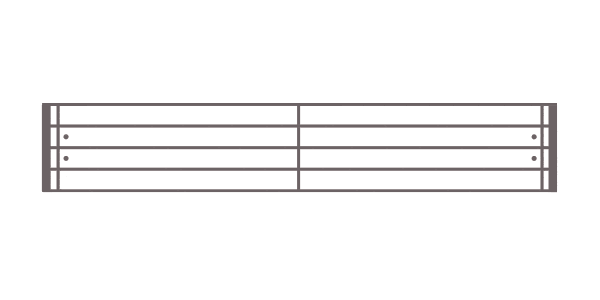
* The start repeat symbol may not be included if appearing at the beginning of a section.
Note Duration
Note duration refers to the length of a note or notes.
In chord notation, you might get some impression of how long to play a particular chord by the placement of chord names above the lyrics.

In guitar tab you may occasionally see the fret numbers distributed based on their value e.g. half note would take up half a bar.
While both forms described above are useful, the majority of the time rhythm notation borrows heavily from standard music notation.
So, if you know some of the basics, like note duration and how to read a time signature in standard music notation you will find most systems fairly intuitive.
We’ll take a closer look at note types below.
Whole Note (Semibreve)
A whole note or semibreve looks much like an empty circle.
A whole note is equal to 4 beats in a measure.
* I’ve included the number of beats in each of the diagrams below for demonstration purposes. This wouldn’t usually be included.
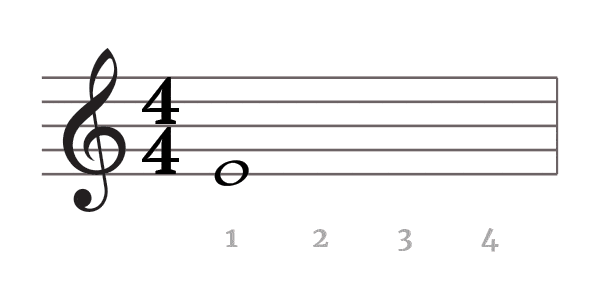
If counting 4 beats to a bar you would count the beat as 1, 2, 3, 4 with the whole note played once, and occupying the entire measure, beginning on beat 1.
Keep in mind (as with the other examples below) that both “Whole Note” and “Semibreve” are interchangeable terms of identical value. In the United States, the term “Whole Note” is used. In the United Kingdom, you are more likely to see the term “Semibreve” used instead.
Half Note (Minim)
A half note or minim looks similar to a whole note, only it also includes a stem, which will face up or down depending on where the note is located on the staff.

A half note’s duration is exactly half a whole note e.g. 1/2. If counting 4 beats to a bar, you would count 1, 2, 3, and 4 with the notes occurring on beats 1 and 3.
Quarter Notes (Crotchet)
A quarter note or crotchet looks similar to a half note only the head of the note is filled in.
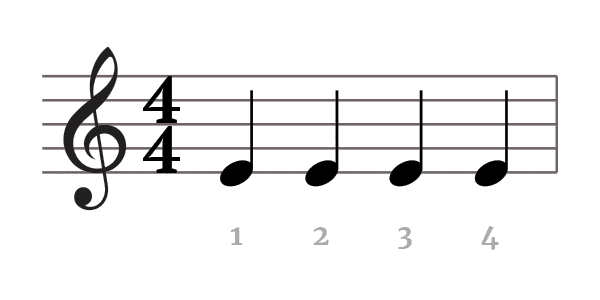
Quarter notes take up a quarter of a whole note. If counting 4 beats to a bar, a quarter note represents 1 beat of 4. To count quarter notes simply count 1, 2, 3, 4 with a note falling on each beat in the bar.
As a quarter note is essentially 1 of 4 beats in 4/4 timing (the most common time signature) we refer to quarter notes as a basic unit of time. When incorporating notes with shorter note durations we subdivide quarter notes into smaller units e.g. 8th and 16th notes.
8th Note (Quaver)
An 8th note or quaverlooks similar to a quarter note, only a curvy line referred to as a “flag” is added to the stem.

If grouped (as shown below), instead of a flag the notes appear connected by a “beam“. Notes with smaller values than defined by the time signature are usually grouped using beams. The strongest note is the first note of the group.

8th notes occupy one 8th (1/8th) of a measure.
If counting 4 beats to a bar, you would count 1 & 2 & 3 & 4 &……
8th notes would occur on the numbers 1, 2, 3, and 4 along with the “&” in between.
If you have a guitar handy, try strumming 8th notes using downstrokes on beats 1, 2, 3, and 4 and upstrokes in between the quarter note beats.
This is referred to as “subdivision” as the quarter notes are divided into two parts.
16th Note (Semi-quaver)
16th notes or semi-quavers, look much the same as 8th notes except an additional flag, or beam is added.

A 16th note occupies one 16th (1/16th) of a measure. To count 16th notes you would add additional letters to the previous example of 8th notes.
For example, 1 e & a 2 e & a 3 e & a 4 e & a…
How are notes shorter than a 16th note displayed in rhythmic notation?
If we had included a 32nd note in our list above, the stem would have three flags or be joined by three beams. If we included a 64th note there would be 4 flags or the notes would be grouped by 4 beams and so on.
Rests
Rests, as the name implies, are periods where nothing is played. Like note duration, rests are differentiated by the symbols used.

Whole Note Rests
A whole note rest symbol looks like a rectangle hanging upside down. As per the whole note example above, a whole note rest’s duration is equal to 4 quarter notes.
Half Note Rests
A half-note rest is similar to a whole note rest only, instead of being below the line (as in the example above) it sits above the line and occupies 2 quarter notes.
Quarter Note Rests
Quarter note rests look kind of like a squiggly line (as per the example above) and occupies 1 quarter note.
8th and 16th note rests
Finally, 8 and 16th note rests appear as diagonal lines with a loop attached to the left-hand side of the stem. Their duration is exactly the same as an 8th or 16th note.
Dotted Notes and Ties
Dotted notes and ties are used to increase the note duration of a particular note.

For example, a dotted half note e.g. a half note with a dot appearing after it would extend the duration of a half note to 3/4 of a whole note, or 3 beats, instead of two.

In the example above, the first quarter note is dotted, followed by an 8th note and two-quarter notes. This results in the equivalent value of 4 quarter notes being played in the measure.
A tie is used to combine notes. For example, A half note and quarter note with a tie between would equal 3 beats.
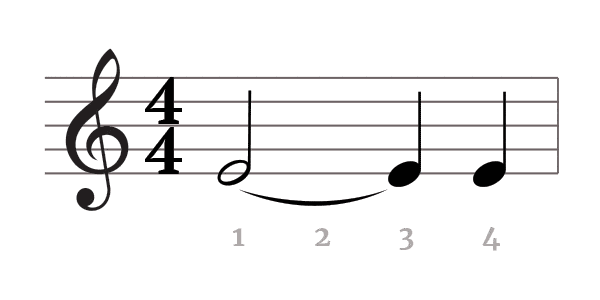
Ties are shown as curved lines connecting two notes of the same pitch, either above or beneath the note symbols. When a tie is shown, the two notes should be played as one. On the guitar you would let the note ring out/sustain.
Ties are similar to slurs, only in the case of slurs the two notes are not of equal pitch. This means the curved line begins on a different line of the staff to where it ends, and all notes are to be played, and played as smoothly as possible e.g. legato.
Tempo

The tempo dictates the speed of the music based on the pace of the constant pulse we described in the introduction.
It is indicated by a quarter note icon placed above the musical staff or above the horizontal lines, representing the guitar’s strings in guitar tab.
The tempo of a song is measured in BPM (beats per minute).
For example, a song played at 120 BPM would be played at a tempo of 120 beats per minute. A song played at 80 BPM would therefore be played at a slower pace than 120 BPM.
It’s important to remember tempo and rhythm are two entirely different things. Changing the rhythm of a song won’t change the song’s pulse, but it will change the feel of the music e.g. how you tap your foot to it.
Slash Notation
Slash notation is another form of rhythmic notation, but unlike standard music notation, it’s best thought of as a form of shorthand.
Rhythm slashes are used for notating chords, as a result as they do not indicate pitch, so are often accompanied by the chord name written above the staff.
If used in guitar tab the fret numbers may be shown first followed by rhythm slashes indicating the previous chord is to be continued.
Regardless of the platform, depending on how it is notated, the different slashes may or may not provide precise rhythmic information.
For example, if the slashes do not include stems, in many cases it is left up to the guitarist to interpret the slashes however they like.
For example, in the diagram below the rhythm slashes tell us that an Am chord is to be played over 4 beats. The slashes are not telling us the chord is to be played 4 times, on the beat, only that it is to be played over the complete measure.

While that can be useful, when stems, and whole and half note symbols are used (based on the standard notation symbols for note duration) we get a much better idea of the song’s intended rhythm.
For example.

In the measure above we have a half note followed by 2 8th notes followed by a quarter note.
The rhythmic information being described in slash notation uses the same or very similar note symbols described above in our section on note duration. So once you are familiar with the different symbols, slash notation should be simple enough to follow.
Time Signatures

The time signature is displayed as two vertical numbers at the beginning of the first measure to the right of the Treble Clef.
The time signature is key to understanding the rhythm of a song and is where the information we have covered above all comes together.
But, time signatures can be confusing when first encountered, especially as it’s understandable to think of them as fractions, which they are not e.g. 3/4 timing is not the same as 6/8 timing.
This can take some time to get used to, so it pays to keep in mind music is not mathematics.
Types of Time Signatures
Time signatures can either be simple, compound, or irregular (e.g. odd time). We’ll explain some of the basics of simple time signatures below, before taking a closer look at compound and odd time signature examples.
What does the top number of a time signature mean?

The top number of a simple time signature tells us how many beats there are to each measure.
If the top number is 4 this means there are 4 beats to each bar.
1, 2, 3, 4, 1, 2, 3, 4…
If the top number was 3, there would be 3 beats to each bar and so on. Technically any number can be used for the top number.
As guitarists, the top number is generally of the most interest to us, but it doesn’t tell us everything.
What does the bottom number of a time signature mean?

The bottom number tells us the value of each beat e.g. quarter note, 8th note, etc. Because of this, the bottom number will always be divisible by 2.
For example, if the bottom number is a 4 each note will be a quarter note. This is because 4 quarter notes make up a whole note.
If the bottom number was 8, we would know the value is 1/8 of a whole note e.g. an 8th note. If the bottom number were a 2, the value would be a half note.
It’s important to keep in mind we don’t need to use the exact number of beats specified by the bottom number e.g. in 4/4 timing you don’t have to use 4 quarter-note beats. The notes just need to add up to the equivalent of 4 quarter notes e.g. a half note and 2 quarter notes.
Why Does the Bottom Number Matter?
If you are anything like me when first encountering a time signature you might be thinking, why does the bottom number of a time signature matter? after all, the top number tells us how many beats to count, why does the note value matter?
It’s important because the bottom number is responsible for organizing how the notes are measured within a bar.
For example, 4/4 time consists of 4 quarter-note beats. And as we know each note doesn’t have to be a quarter note, the total just needs to equal 4 quarter notes, aka a whole note. The bottom number of the time signature provides this information, allowing the music to be organized into measures.

Simple and Compound Time Signatures
Before we dive into simple and compound time signatures, we need to quickly revisit the concept of meter (aka metre in the United Kingdom).
As we know, patterns of strong and weak beats are referred to as a song’s meter. Simple and compound time signatures can be a duple, triple, or quadruple meter based on the number of groups within a measure.
For example. The diagram below shows 2 groups of 2 8th notes in 2/4 time. This is an example of duple meter.

The next example is in 3/4 time. As there are 3 groups of 8th notes this is an example of triple meter.

Lastly, we have an example of quadruple meter, which contains 4 groups of beats to a measure.

While it may appear confusing at first, a song’s meter is not entirely the same as a measure or bar. For example, a measure contains the number of beats based on the time signature. The meter describes the pattern of beats.
While this may seem arbitrary, keep this in mind as we’ll circle back to this shortly.
How to tell the difference between simple and compound time signatures
If a time signature is simple, it means the beats can be broken down into groups of two. Not divided, as we discussed above concerning duple, triple, and quadruple meters but subdivided into groups of two.

Unlike compound time signatures which we’ll discuss shortly, the top number of a simple time signature tells you exactly how many beats there are in a bar, so if the top number is 2 the time signature is also duple.
2/2 (shown above) is an example of simple duple, as the two half-note beats can be divided into 2 quarter notes.
Alternatively, 4/4 time consists of 4 quarter-note beats. Which can be subdivided into 8 quarter notes, as 4 groups of two. This means 4/4 time is simple quadruple time.

What’s the Point of 2/2 compared to 4/4?
If discussing mathematics, 2/2 (aka cut time) and 4/4 (common time) would be of equal value, however, time signatures are not fractions. Musically the difference can be heard due to how the beats are accented, giving each of the time signatures a different feel.
Generally, any time signature with a 2, 3, or 4 for the top number will be simple, including 3/4 time.
How does 3/4 timing sub-divide into groups of two?
In the case of 3/4 timing, based on our knowledge of time signatures we know that there are three, quarter note beats to a measure.

The quarter notes can be subdivided into 3 groups of 2. This means 3/4 timing is an example of a simple triple meter.
How to Identify Compound Time Signatures
If the top number of the time signature is greater than, or equal to six, and a multiple of three (with the exception of the number three itself, as demonstrated above) the time signature will be compound.
In most cases, the lower number in a compound time signature will be 8, but may also be 16, 2, or 4.
While the top number establishes the number of beats to a bar in a simple time signature, we don’t interpret the top number the same way in compound time signatures. The top number doesn’t really tell us how many beats to a bar.
When counting beats within a compound signature we group beats based on the top number. For example, in 6/8 timing, the 6 divides into 2 groups of three, giving us two beats to the bar.
Because the notes are grouped in this way, the main beat is a dotted note e.g. a dotted half note (3 beats).
Why do we group the notes like this?
Keep in mind a note value of 1.5 (a dotted half note) can’t be written into a time signature e.g. you can’t put 1.5 as the bottom number (remember the bottom number has to be a factor of two), so instead, to communicate this using rhythm notation we use compound time.
If counting in compound time you would count 1 and a 2 and a 3 and a 4. When counting simple meters you are more likely to count 1 and 2 and 3 and 4 …..
To help clarify, we’ll take a look at an example of 6/8 timing, the most likely compound time signature you will encounter.
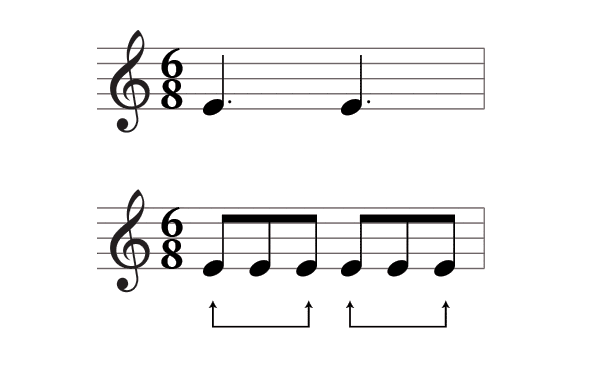
As we know, in 6/8 time the 6 beats are really two beats meaning they must be dotted quarter notes. Dotted quarter notes are not divisible by two, but are by three, giving us 2 groups of three 8th notes, making a 6/8 time signature a compound duple meter.
Another example of this is 9/8 time.

In this example, we have three dotted quarter note beats. This means we are in triple meter, as opposed to the previous example which showed 2 groups of three. And, as each of the dotted quarter notes is only divisible by three we know it is compound triple time.
Irregular Beats
Lastly, we come to irregular beats or odd-time signatures. Irregular time signatures feel very different from simple and compound time signatures. They feel less natural, and are a little more difficult to tap your foot to.
This is because they are neither duple, triple, or quadruple time.
The top number of an odd-time signature can’t be broken down into evenly distributed groups of two, three, or four, so a combination is used.
This means in the case of irregular time signatures, the notes are grouped in uneven groups of beats.
The most common irregular or odd-time signatures are 5/4 and 7/4.
As we know, in 5/4 time, based on the time signature there are 5 quarter note beats to a bar. But, this doesn’t mean there are 5 beats to a bar. As is the case with compound meter we group the 5 beats into two groups, only in this case we now have one group of 2 smaller beats and one group of 3, because the number is odd we cannot have two equal note values.

In simple terms, the grouping effects where the accents occur. So if we have a group of two followed by a group of three, the accents occur on beats 1, 3

Alternatively, if we arranged 5/4 into a group of three followed by a group of 2 the accents would occur on beats 1 and 4, changing the feel of the music, and demonstrating how even the subtlest of change can greatly affect the rhythm of a song.
Final Thoughts
If you’ve never really given rhythm much thought before, the information above might take a little bit of time to wrap your head around. But keep in mind rhythm is second nature to most of us. Most of us can tap our foot to a song. But, it’s another story to explain what your foot is actually doing.
While rhythm notation can appear complex (because it is!) Keep in mind, its the best system we have available to communicate rhythmic concepts, and after a while does become easier to understand
It’s also important to remember that music isn’t mathematics. While it’s tempting to try to find hard and fast rules in music (and there are plenty of those as well), music is an imperfect system, and it takes time to get used to specific aspects of it.
I hope the information above helps you better understand rhythm and helps you apply some of the concepts mentioned above when learning new music or writing your own music.



![What is a Sus Chord? [A Guide To Suspended Chords] 40 What Are Sus Chords?](https://theacousticguitarist.com/wp-content/uploads/2021/08/what-are-sus-chords.gif)